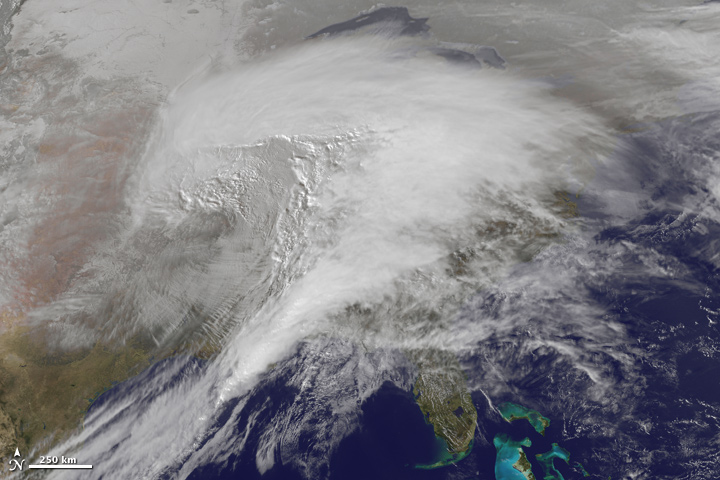Science News
Earth Update, February 2011
February 11, 2011

In a similar tradition to our monthly “Universe Update”, the first Thursday of every month, the Morrison Planetarium is now hosting “Earth Update” at the 7:30 and 8:30 planetarium shows during NightLife. Ryan Wyatt, Director of the Morrison Planetarium and Science Visualization here at the Academy, working with Tim Horn, Producer of Climate and Earth Science Visualization, select their favorite Earth-bound stories from the past month and give a brief run-down of current discoveries while taking audiences on a guided tour of our beloved planet.
We’ll give you the same update here each month, in the same order Ryan does, starting and ending closest to our home city, San Francisco.
With our unseasonably warm and clear weather, it’s hard to fathom the “monster storm” that rocked 30 states last week. Luckily, NOAA and NASA satellites provided us with stunning images.
Sadly, despite this cold weather in North America, the Arctic continues to warm. They are most likely related, according to NASA:
The overall configuration of warmer-than-normal temperatures in the north and cooler-than-normal temperatures in the south probably results from a climate pattern known as the Arctic Oscillation (AO).
Heading to warmer climes… the Galapagos Islands have long been part of the Academy’s rich expedition history and specimens collected over 100 years ago are proving fruitful research today. We featured a recently published study on the history of avian pox on the Galapagos in Science in Action.
The Academy hopes to continue this rich history with its upcoming, multi-disciplinary expedition to the Philippines this spring. Academy scientists, working with Filipino researchers, hope to document the area’s fantastic biodiversity in order to help inform future conservation priorities. This all fits into the Academy’s mission to “Explore, Explain and Protect the natural world.” The Morrison Planetarium, Science in Action and Science Today will bring you updates of the expedition in real time, so stay tuned.
“This powerful little lady is spreading her curses and blessings across the planet. She’s the real deal.” That’s Bill Patzert, an oceanographer and climatologist at NASA’s Jet Propulsion Laboratory sounding lovelorn over this year’s very strong La Niña event. Lovelorn is also very cautious about her:
Climatic impacts include heavy rains and flooding, which has damaged crops and flooded mines in Australia and Asia. It also has resulted in flooding in northern South America and drought conditions in Argentina.
Speaking of Australia, Cyclone Yasi hit the flood-recovering Queensland last week pretty hard. Again, NASA satellites give us a birds-eye view of “one of the most powerful cyclones to strike the region in decades.”
Surprising scientists, the Japanese volcano Shinmoe-dake erupted on January 26th, spewing ash and lava rocks into the air. Though lives and air travel weren’t threatened, the volcano is being monitored as it continues to erupt intermittently.
Finally, 2010 is tied with 2005 as being the warmest year on record. Go ahead and spread this news to the climate-deniers, too. The globe is warming, and there are multiple records and data to back it up, according to NASA’s Earth Observatory:
All four records above show peaks and valleys in sync with each other. All show particularly rapid warming in the past few decades. And all show the last decade as the warmest.
Come visit the Academy for NightLife on March 3rd for the next “Earth Update,” when Ryan and Tim will give you more of the latest news on Academy research and our home planet.
NASA animation by Jesse Allen, using data provided courtesy of the GOES Project Science Office.